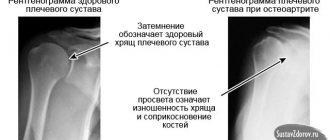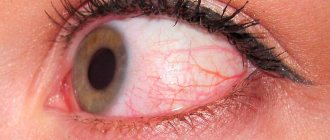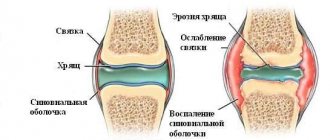Swelling that appears on the body often indicates a serious illness. To find out why your hands (both or one of them) swell, you need to check whether any changes have occurred related to the functioning of the liver, heart, kidneys, which are the most important organs of the human body.
If swelling becomes noticeable, accompanied by redness of the skin, this fact should not be ignored. It is better to immediately consult a doctor to determine the causes of this disease.
Symptoms accompanying swelling
Initially, edema can be detected by swollen fingers, comparing the diseased and healthy limbs. You can identify swelling by pressing your thumb on the swollen area where the bone is located. When the finger is removed, a depression is formed that does not disappear immediately.
When swelling is caused by non-pathological causes occurring in the body, then this swelling will disappear on its own.
If it occurs in the morning after a night’s sleep, it will pass without a trace within three hours and will not affect the person’s condition. If it does not subside until the evening, it means that there has been a malfunction in the functioning of some system in the body. If there are abnormalities in the functioning of the internal organs, the hands swell both in the morning and in the evening or at night.
Swelling is easy to notice:
- the jewelry on your hand will get in the way;
- it will be difficult to put on and take off the ring;
- If you clench your fingers into a fist, the skin will become very stretched.
At the same time as a swollen hand, they sometimes feel numbness , which is why we can definitely say that something is abnormal in the body. Even if a swollen limb does not cause disruption to normal life, you should consult a doctor.
How to get rid of swelling
What to do if your arm, in particular your hand, is swollen? The most effective method of treating edema, except for those caused by cardiovascular failure, is physical therapy, which helps restore venous and lymphatic outflow. This helps to normalize muscle activity, displacement of soft tissues, compression of venous and lymphatic vessels, which regulates the outflow of fluid from the body. You can clench your hand into a fist, performing the exercise 10-20 times, lightly press it with another hand, and massage it.
In any case, treatment for swelling of the hand depends on the cause that caused it. If the symptom is caused by a physiological factor (for example, excessive fluid intake, increased load on the limb, etc.), cold compresses can be applied to the swollen hand. This could be a heating pad with cold water, or any cold product from the refrigerator. Cold helps to constrict blood vessels and improve blood circulation.
Medications
Swelling of the hand, which occurs irregularly, is easy to eliminate. Generally recognized medications will come to the rescue:
- diuretics that help remove excess fluid from the body (Furosemide, Triamzide, etc.);
- antiallergic, capable of treating swelling of the hands caused by an allergic reaction of the body to a specific allergen (Suprastin, Diazolin, Tavegil);
- antibiotics that eliminate infectious or purulent inflammation (Amoxiclav, Lincomycin);
- products with potassium and magnesium that replenish the lack of substances in the body (Panangin, Kudesan).
How else can you treat swelling of the hand? The use of special ointments is often prescribed to help eliminate local swelling and pain. Surgery is performed extremely rarely if there is a purulent inflammatory process and sepsis. Surgery is also prescribed when a tumor-like formation has formed.
Folk remedies and recipes
You can relieve swelling from your hand using folk remedies. This can be lemon (3 pieces) and fresh horseradish (130 g). Pass the ingredients through a meat grinder, mix, then take 1 tsp. on an empty stomach and before bedtime. The total duration of treatment is 2 weeks.
Swelling of an area of the limb such as the hand is treated with baths and compresses. Pour a saline solution prepared in a ratio of 1 tsp into a container of water. salt per 200 ml of liquid. Place the swollen limb in the bath for 10 minutes. Carry out the procedure 5-6 times a day.
Local remedies for eliminating swelling and bruising of the hand caused by traumatic injury often use a compress of raw potatoes. The product is rubbed with a grater to obtain juice, in which a piece of gauze is soaked and applied to the swollen area. Manipulation is carried out 3-4 times a day.
Causes of hand swelling
The most common reason why the right or left hand swells in the morning is considered to be excessive consumption of water or other liquids shortly before bedtime.
the amount of food eaten at night may also influence Such tumors may disappear after some time from the moment of awakening.
Others may not subside for days or weeks. The causes of their occurrence, which are constant, indicate the presence of serious diseases or exacerbations or complications of some previously occurring diseases in a person. This often happens due to poor functioning of the heart muscles, when blood stagnates due to its slow pumping.
Swelling begins in the legs, gradually rising to the palms, hands and fingers. As a rule, if the legs and arms swell, the reasons lie in heart failure. Some types of swelling are relieved only after taking diuretics . In older people, the presence of edema can indicate malfunctions in the venous or cardiovascular system.
Limbs often swell in pregnant women . It mainly occurs from the 28th week of pregnancy to the 42nd week and shortly before birth. The reasons why hands swell at this time lie in the fact that if there are abrasions, cuts, wounds on the skin surface of the limbs, then microbes and bacteria disappear through them. Such an infection can result in significant pain for a woman if you press on the swollen area.
Sometimes there is an elevated temperature (38−40°), headache, and dizziness. Such swelling occurs quite rarely. They are caused by a weakened immune system of a pregnant woman , a consequence of severe trauma. In every case of swelling, pregnant women must urgently consult their doctor, otherwise the tumor may spread to adjacent areas of tissue and increase the area of swelling.
Factors that cause swollen hands
Often, swelling on the phalanx of the fingers is the result of a simple bruise, injury or fracture of the finger, and the onset of inflammation is the body’s reaction to what happened.
You just need to put something cold on the swollen area for a while, and then consult a doctor to avoid possible consequences. But if there are other factors. which explain the swelling of the hands.
- Allergy to dish soap (detergent, cleaning products), household chemicals, laundry detergent. First, they find out whether these are really the consequences of an allergic reaction. To do this, do not use the listed substances or wear rubber gloves, which serve as protection from an aggressive environment.
- An allergic reaction, accompanied by swelling of the extremities, can be caused by the consumption of any exotic food, rare fruits that have never been present in the diet before.
- Subjective intolerance associated with animal hair, fur, feathers.
- Swelling that occurs due to excessive sensitivity of the skin on the face and body to the cosmetic product used: hand cream, tanning.
- A local allergic reaction, expressed in swelling of the extremities, can be provoked by insect bites (wasps, bees).
- Swelling can be caused by insufficient blood circulation and blockage of blood vessels.
- Diseases of the thyroid gland lead to significant changes in the fingers due to swelling of the hands of the upper extremities. You will need to consult an endocrinologist.
- Swollen fingers are common in pregnant women due to the presence of excess fluid in the body. In this case, upon the direction of the attending physician, urine tests are taken; their results should contain no protein. The swelling is relieved with a diuretic.
- Poor performance of the kidneys, heart, and liver leads to swelling in the hands.
- Ordinary fatigue caused by prolonged work without rest, poor diet, insufficient and poor sleep can cause swelling of the hands. Then you should think about your health and make adjustments to your daily routine to avoid such consequences.
- Hands swell during heavy and prolonged physical exertion as a result of carrying heavy loads or digging up a garden plot. You don't need to work too hard continuously. Work should be combined with rest breaks so as not to overwork your body.
Pathologies that cause swollen hands
In addition to these factors, swelling is caused by renal failure, abnormalities in the functioning of the kidneys, which are responsible for the process of removing fluid from the body. If they do not perform this task, then areas of the body such as legs, arms, eyelids, and other organs will certainly begin to swell.
The water balance is disturbed due to improper functioning of the kidneys . The removal of fluid slows down, it accumulates in the soft tissues of the hands. Infections and viruses that affect the kidneys can slow down their performance.
When both hands or one of them swell, for example, the right hand swells, the reasons may be the following:
- decreased protein in the body;
- pregnancy;
- pathologies in the functioning of the vascular system;
- tumor formation;
- swelling that occurs after surgery;
- disruption of the endocrine system;
- swelling associated with heat.
Felon
This is perhaps the most common cause of swelling and redness of the finger. This type of inflammation is infectious in nature and is often accompanied by the formation of pus in the soft tissues of the phalanges. Infectious agents, and most often these are staphylococci, streptococci, enterococci, penetrate into the tissues of the finger through minimal damage to the skin (abrasions, cuts, splinters, needle pricks, pulling out hangnails, injuries during manicure, etc.). Sometimes you can prick your finger when cutting fish. Very often, the entrance gates of infection go unnoticed, and patients complain that their finger is swollen for no reason.
Due to the peculiarities of the anatomical structure, purulent inflammation does not spread over the surface area of the skin, but deep into the soft tissues and can be complicated by damage to the tendons, muscles, joints and bones of the phalanges.
Panaritium is accompanied by a number of characteristic symptoms:
- sore finger, not only swollen, but also painful;
- the pain is tugging, bursting in nature, disturbing not only when moving, but also at rest;
- the skin over the affected area turns red, in some cases begins to turn blue, becomes smooth, as if stretched, shiny and hot to the touch;
- sometimes a person’s general well-being suffers, weakness appears, and body temperature rises;
- in the center of the redness you can see white pus; in some cases, pus accumulates and is visible under the nail plate;
- As a rule, only one finger is involved in the inflammatory process (index, little finger, etc.) - the one that has become the entry gate for infection.
This is what felon looks like.
Depending on the depth of inflammation and the severity of the condition, the following types of felon are distinguished:
- cutaneous – only the skin is affected;
- subcutaneous – inflammation is localized in the subcutaneous fatty tissue;
- tendon – the tendons of the finger muscles are involved in the pathological process;
- articular – purulent lesions of the interphalangeal and/or metacarpophalangeal joints;
- subungual - pus accumulates under the nail bed, such panaritium most often develops due to a splinter getting under the nail or due to the bad habit of biting nails;
- periungual (paronychia) - inflammation of the periungual ridge of the finger, the main cause is pulling out hangnails;
- bone - the bone tissue of the phalanges of the fingers is involved in the pathological process; it develops infrequently and, as a rule, as a complication of the subcutaneous form of panaritium.
Schematic representation of the forms of felon: a) cutaneous; b) subcutaneous; c) tendon; d) bone; e) articular; e) cufflink type
What to do if your finger is swollen due to felon? Treatment includes a complex of conservative and surgical techniques. The patient must be prescribed anti-inflammatory, antibacterial and painkillers. Surgical treatment of the purulent focus is also performed. The felon is hidden, the pus is eliminated, and the wound is drained and washed with antiseptic solutions.
It is important to know! When panaritium develops, any warming procedures, compresses and ointments are strictly prohibited. Such “treatment” is likely to lead to deeper and more extensive purulent tissue damage and the development of complications, for example, the bone or tendon form of the disease.
If a child’s finger is swollen, then most likely the reason lies precisely in the development of felon, because children, like no one else, are prone to the habit of biting off hangnails and biting their nails.
How to remove swelling
Hands generally swell during the hot season or in small, cramped rooms with a lot of equipment and a significant number of people. Most often, in such situations, the cause of swelling of the hands will be considered a violation of water metabolism in the body.
That is, fluid is not completely removed from the body due to poor kidney function due to the intake of large amounts of fluid.
In this case, swelling is removed in the following ways:
- They start by removing all objects that put pressure on the wrist from their hands: bracelets, watches, etc. Without them, blood flow in the hand will improve. Women should not carry bags on the elbow, so as not to put their weight on the veins.
- If your fingers swell, you should not eat spicy, salty foods or drink any alcoholic beverages. All these products retain fluid in the body for a long time.
- In case of swelling of the upper extremities, you should reduce the amount of fluid consumed per day, including both pure water and tea, soup, coffee, and dairy drinks. Stop drinking approximately 2 or 3 hours before bedtime, allowing the body to rid itself of excess fluid.
- For swollen hands, the diet should include more kefir, cottage cheese, cucumbers, viburnum juice, and watermelons. These products contain many vitamins and minerals, which will help relieve swelling.
- During the hot season, it is necessary to ventilate the premises, turn on air conditioners and fans.
- When your fingers swell, you can relieve the swelling with a contrast shower. By dramatically changing the temperature of the water, you can have a beneficial effect on the circulatory system and greatly reduce swelling of both the arms and legs. A trip to the bathhouse (sauna), taken at least 2 times a month, will help improve water metabolism.
- After dinner, you can make a compress of cabbage leaves and burdock on swollen areas of your hands.
- It is useful to sometimes take a warm bath (36-37°) with the addition of sea salt in small quantities (up to 300 g). The salt will dissolve without stirring the water. You can take a fragrant bath for up to half an hour.
- Physical exercises will help eliminate swelling: race walking, swimming, running, cycling. Five or ten minutes of exercise in the morning is useful. In the evening, you can also do simple exercises 2 hours before bedtime.
Joint diseases
In second place among the causes of swelling of the fingers are diseases of the small joints of the hands.
Arthritis
If the joint on your finger is swollen, you need to rule out the development of arthritis. In the case of a single lesion, you need to think about a simple infectious inflammation of the joint, but if several joints swell at the same time, most likely the person has one of the rheumatological diseases, for example, rheumatoid arthritis.
With rheumatoid arthritis, several joints of the hands are simultaneously affected, as well as other joints in the body (knees, ankles, wrists, elbows, etc.). The pathological process is symmetrical, that is, the joints on both upper extremities suffer and swell at the same time. Uncharacteristic locations of inflammation in rheumatoid arthritis are the distal interphalangeal joints, the metacarpophalangeal joint of the thumb, the proximal interphalangeal joint of the little finger, the sacroiliac joints and the lumbar spine (the so-called “exclusion joints”).
Rheumatoid arthritis is characterized by pain. The joints hurt both at rest and with movement, the pain intensifies with palpation and transverse compression of the joints. Morning stiffness of the injured fingers is typical, which goes away after a few hours.
The disease has a long course, with periods of exacerbation and swelling of the joints of the fingers followed by remission and subsidence of all symptoms. Over time, specific deformations of the hands are formed, which often cause loss of performance and disability, especially in children with the development of juvenile rheumatoid arthritis.
If the joints on the fingers are systematically swollen, the cause may be other forms of arthritis, for example, inflammation of the joint due to gout, psoriasis, systemic lupus erythematosus, scleroderma, dermatomyositis and other systemic connective tissue diseases.
Arthrosis
Another common cause of swelling of the joints on the fingers is deforming osteoarthritis. This is a degenerative lesion of intra-articular cartilage with further destruction of other components of the joint and the development of severe deformation of the joints. From time to time, arthrosis is aggravated by the development of reactive synovitis (inflammation of the joint capsule); it is during this period that swelling of the small joints of the hands occurs and pain increases during movements.
Over time, more and more joints are drawn into the pathological process, which are destroyed and lead to typical deformities. Nodular formations appear on the fingers - Bouchard's and Heberden's nodes.
A characteristic view of the hand of a patient with deforming osteoarthritis, Bouchard and Heberden nodes are clearly visible
A rheumatologist knows how to treat joint diseases. It is he who should be contacted if such a problem develops.
Treatment of edema
Before starting treatment, the doctor (therapist, allergist) conducts diagnostics, starting by examining the patient from the palms, fingers, and moving to the shoulder joint. The purpose of the examination is to find out the cause of fluid accumulation in the extremities.
As prescribed by the doctor, the patient will need to undergo a urine and blood test . A test may also be ordered to check for an allergic reaction.
Based on the data obtained, treatment is carried out. Severe cases of hand swelling associated with purulent processes require surgical intervention . In cases where surgery is not required, the patient is prescribed various medications: antibiotics, vitamins, diuretics (diuretics). They help relieve excess osmotic pressure and increase blood flow.
Potassium supplements are also prescribed to maintain body balance. The results of the treatment will be visible within a day, the swelling will begin to subside from the fingers to the wrist. Swelling in the hands caused by injuries disappears slowly, after 2-3 weeks.
Folk remedies
For swelling, compresses (baths) with the addition of medicinal plants help well. For this purpose, tinctures of rose hips, chamomile, birch leaves, parsley, calendula, nettle, and St. John's wort are used.
Rosehip decoction is prepared in a thermos with 2 tbsp. l. rose hips, which are poured with boiling water (0.5 l). The broth will be ready in 20 minutes. You can drink it throughout the day or add it to a compress solution.
To quickly relieve swelling, you need to brew string, chamomile, mint and add half a glass of rosehip to the solution. Moisten gauze with the resulting mixture, wrap it around the swollen area and leave for 30 minutes, then you can lubricate the area with moisturizer.
The use of folk remedies
You can eliminate swelling in your hands using some traditional medicine recipes:
- Infusion of bear ears. To prepare the medicine, you need to take a tablespoon of prepared plant material and pour all 235 ml of boiling water. The mixture should steep for 1 hour, after which it should be drunk throughout the day in several doses.
- Decoction of anise seeds. Four tablespoons of vegetable raw materials are poured into 240 ml of boiling water. The mixture is simmered over low heat for 7 minutes. The prepared decoction is taken two tablespoons three times a day.
- Pumpkin juice. You need to drink 220 ml daily. The course of treatment lasts one month.
- Decoction of pine buds. Pour a teaspoon of raw material into a glass of water and cook over low heat for 3-5 minutes. The mixture is infused for 2-3 hours, after which it is drunk in several doses throughout the day.
- Cucumber pickle. Take 2 glasses per day. When using this method of treatment, swelling recedes slowly, but does not return.
By following all the recommendations of doctors and using simple treatment methods, you can get rid of swelling in your hands and improve your overall well-being. But if after several days of therapy there is no relief, it is necessary to undergo additional examination to clarify the diagnosis.
Diagnostic methods
Ultrasound of vessels and veins of the lower extremities
You can diagnose leg swelling yourself by pressing your finger on the shin. If a mark remains at the site of pressure and does not disappear for some time, then edema is present.
In addition, it is possible to notice an unpleasant symptom after removing socks, when traces of the elastic remain.
If you notice swelling of your lower extremities, you should consult a specialist. Typically, the following studies are prescribed to make a diagnosis and exclude dangerous pathologies:
- urine and blood test
- ECG
- Ultrasound of the lower extremities
- Ultrasound of internal organs
- CT scan
If indicated, a test may be prescribed to determine the level of hormones in the body and blood sugar levels.











